A Central Spiral Split Rectangular-Shaped Metamaterial Absorber Surrounded by Polarization-Insensitive Ring Resonator for S-Band Applications
Abstract
:1. Introduction
2. Design and Methodology
3. Theory of Absorption
4. Characterization of the Absorber
5. Analysis of Absorber
6. Analysis of Current and Field Distribution of Unit Cell
7. Array Analysis
8. Comparison
9. Sensing Application
10. Conclusions
Author Contributions
Funding
Institutional Review Board Statement
Informed Consent Statement
Data Availability Statement
Conflicts of Interest
Appendix A
| (θ & φ) | Angle | Parameter | Frequency Band | Resonance Frequency (GHz) | ε | µ | η | Absorption (%) | Reflection (%) |
|---|---|---|---|---|---|---|---|---|---|
| θ | 15° | S11 | S | 3.1 | −0.364 | 0.402 | 0.001 | 99.94 | 0.06 |
| θ | 30° | S11 | S | 3.1 | −1.506 | 1.538 | 0.001 | 99.89 | 0.1 |
| θ | 45° | S11 | S | 3.1 | 1.12 | −1.18 | 0.002 | 999.89 | 0.01 |
| θ | 60° | S11 | S | 3.1 | 1.12 | −1.18 | 0.002 | 99.89 | 0.1 |
| θ | 75° | S11 | S | 3.1 | 1.12 | −1.18 | 0.002 | 99.89 | 0.1 |
| θ | 90° | S11 | S | 3.1 | 1.12 | −1.18 | 0.002 | 99.89 | 0.1 |
| 0° | S11 | S | 3.1 | −0.364 | 0.402 | 0.001 | 99.94 | 0.06 | |
| φ | 15° | S11 | S | 3.1 | −0.364 | 0.402 | 0.002 | 99.94 | 0.06 |
| φ | 30° | S11 | S | 3.1 | −0.364 | 0.402 | 0.002 | 99.94 | 0.06 |
| φ | 45° | S11 | S | 3.1 | −0.364 | 0.402 | 0.002 | 99.94 | 0.06 |
| φ | 60° | S11 | S | 3.1 | −0.364 | 0.402 | 0.002 | 99.94 | 0.06 |
| φ | 75° | S11 | S | 3.1 | −0.364 | 0.402 | 0.002 | 99.94 | 0.06 |
| φ | 90° | S11 | S | 3.1 | −0.365 | 0.402 | 0.002 | 99.94 | 0.06 |
| θ | 15° | S21 | S | 1.95 | −23.845 | 42.08 | −0.00001 | 0.3 | 99.68 |
| S21 | 3.49 | 0.904 | −286.47 | −0.0008 | 8.1 | 91.9 | |||
| S21 | C | 4.155 | 4.244 | −50.389 | −0.0001 | 6.8 | 93.15 | ||
| θ | 30° | S21 | S | 1.95 | −23.83 | 42.107 | −0.0001 | 0.7 | 99.28 |
| S21 | 3.5 | 0.952 | −271.74 | −0.0009 | 0.8 | 91.45 | |||
| S21 | C | 4.155 | 4.406 | −48.616 | −0.0001 | 0.5 | 94.40 | ||
| θ | 45° | S21 | S | 1.95 | 23.833 | 42.107 | −0.0001 | 0.7 | 99.28 |
| S21 | 3.49 | 0.952 | −271.74 | −0.0009 | 8.5 | 91.45 | |||
| S21 | C | 4.155 | 4.406 | −48.616 | −0.0001 | 5.6 | 94.40 | ||
| θ | 60° | S21 | S | 1.95 | −23.833 | 42.107 | −0.0001 | 0.7 | 99.23 |
| S21 | 3.49 | 0.952 | −271.74 | −0.0009 | 8 | 91.45 | |||
| S21 | C | 4.155 | 4.406 | −48.616 | −0.0001 | 5 | 94.40 | ||
| θ | 75° | S21 | S | 1.95 | −23.833 | 42.107 | −0.0001 | 0.6 | 99.23 |
| S21 | 3.49 | 0.952 | −271.74 | −0.0009 | 8.5 | 91.45 | |||
| S21 | C | 4.155 | 4.406 | −48.616 | −0.0001 | 5.6 | 94.40 | ||
| θ | 90° | S21 | S | 1.95 | −23.833 | 42.107 | −0.0001 | 0.7 | 99.28 |
| S21 | 3.49 | 0.952 | −271.74 | −0.0009 | 8.5 | 91.45 | |||
| S21 | C | 4.155 | 4.406 | −42.523 | −0.00001 | 5.6 | 94.39 | ||
| 0° | S21 | S | 1.95 | −22.734 | 42.796 | −0.00001 | 0.3 | 99.68 | |
| S21 | 3.49 | 0.741 | −330.83 | −0.001 | 7 | 92.03 | |||
| S21 | C | 4.155 | 4.303 | −49.603 | −0.0001 | 6 | 93.35 | ||
| φ | 15° | S21 | S | 1.95 | −22.733 | 42.797 | −0.00001 | 0.3 | 99.68 |
| S21 | 3.49 | 0.904 | −286.48 | −0.0008 | 8.1 | 91.89 | |||
| S21 | C | 4.155 | 4.360 | −48.845 | −0.0001 | 6.4 | 93.54 | ||
| φ | 30° | S21 | S | 1.95 | −23.844 | 42.797 | −0.00001 | 0.3 | 99.68 |
| S21 | 3.49 | 0.904 | −286.47 | −0.0008 | 8.1 | 91.89 | |||
| S21 | C | 4.155 | 4.244 | −50.389 | −0.0013 | 6.8 | 93.15 | ||
| φ | 45° | S21 | S | 1.95 | −22.734 | 42.796 | −0.00001 | 0.3 | 99.68 |
| S21 | 3.49 | 0.904 | −286.48 | −0.0008 | 8.1 | 91.89 | |||
| S21 | C | 4.155 | 4.244 | −50.389 | −0.0001 | 6.8 | 93.15 | ||
| φ | 60° | S21 | S | 1.95 | −22.734 | 42.796 | −0.00001 | 0.3 | 99.68 |
| S21 | 3.49 | 0.904 | −286.47 | −0.0008 | 8.1 | 91.89 | |||
| S21 | C | 4.155 | 4.244 | −50.389 | −0.0001 | 6.8 | 93.15 | ||
| φ | 75° | S21 | S | 1.95 | −22.734 | 42.087 | −0.00001 | 0.3 | 99.68 |
| S21 | 3.49 | 0.904 | −286.48 | −0.0008 | 8.1 | 91.89 | |||
| S21 | C | 4.155 | 4.244 | −50.389 | −0.0001 | 6.8 | 93.15 | ||
| φ | 90° | S21 | S | 1.95 | −22.734 | 42.796 | 0.00001 | 0.3 | 99.68 |
| S21 | 3.49 | 0.904 | −286.47 | −0.0008 | 8.1 | 91.89 | |||
| S21 | C | 4.155 | 4.244 | −50.389 | −0.0001 | 6.8 | 93.15 |
| θ & φ | Parameter | Angle | Frequency Band | Resonance Frequency (GHz) | ε | µ | η | Absorption (%) | Reflection (%) |
|---|---|---|---|---|---|---|---|---|---|
| θ | S11 | 15° | S | 1.44 | −9.0441 | 13.8534 | 0.0961 | 97.16 | 2.8 |
| 3.96 | 2.0001 | −1.7139 | −0.0015 | 99.49 | 0.51 | ||||
| C | 4.205 | −2.5891 | 2.0718 | −0.0019 | 99.06 | 0.94 | |||
| 5.025 | 5.2289 | −6.1224 | −0.0076 | 93.79 | 0.62 | ||||
| θ | S11 | 30° | S | 1.44 | −8.965 | 13.5525 | 0.0960 | 97.28 | 2.8 |
| 3.96 | 1.9858 | −1.7044 | −0.0015 | 99.50 | 0.51 | ||||
| C | 4.205 | −2.5797 | 2.0622 | −0.0019 | 99.06 | 0.94 | |||
| 5.025 | 5.2297 | −6.1233 | −0.0076 | 93.79 | 0.62 | ||||
| θ | S11 | 45° | S | 1.44 | −9.0442 | 13.8542 | 0.0961 | 97.16 | 2.8 |
| 3.96 | 2.0032 | −1.7161 | −0.0015 | 99.49 | 0.51 | ||||
| C | 4.205 | −2.59 | 2.0731 | −0.0019 | 99.06 | 0.94 | |||
| 5.025 | 5.2287 | −6.1222 | −0.0076 | 93.79 | 0.62 | ||||
| θ | S11 | 60° | S | 1.44 | −90438 | 13.8538 | 0.0961 | 97.16 | 2.8 |
| 3.96 | 2.0273 | −1.7366 | −0.0015 | 99.48 | 0.51 | ||||
| C | 4.205 | −2.6219 | 2.0969 | −0.0019 | 99.04 | 0.94 | |||
| 5.025 | 5.2295 | −6.1243 | −0.0076 | 93.79 | 0.62 | ||||
| θ | S11 | 75° | S | 1.44 | −9.0439 | 13.8539 | 0.0961 | 97.16 | 2.83 |
| 3.96 | −2.0134 | −1.7259 | −0.0015 | 99.48 | 0.5 | ||||
| C | 4.205 | −2.592 | 2.0735 | −0.0019 | 99.06 | 0.9 | |||
| 5.025 | 5.2299 | −6.124 | −0.0076 | 93.79 | 0.6 | ||||
| θ | S11 | 90° | S | 1.44 | −9.0445 | 13.8543 | 0.0961 | 97.16 | 2.8 |
| 3.96 | 2.003 | −1.7165 | −0.0015 | 99.45 | 0.5 | ||||
| C | 4.205 | −2.5916 | 2.0738 | −0.0018 | 99.06 | 0.94 | |||
| 5.025 | 5.229 | −6.1226 | −0.0076 | 93.79 | 0.62 | ||||
| S11 | 0° | S | 1.44 | −6.429 | 6.748 | 0.107 | 99.382 | 0.6 | |
| 3.96 | 2.039 | −2.331 | −0.0019 | 99.383 | 0.6 | ||||
| C | 4.205 | −6.293 | 3.555 | −0.0021 | 92.91 | 4.8 | |||
| 5.025 | 5.432 | −6.510 | −0.008 | 95.17 | 7.1 | ||||
| φ | S11 | 15° | S | 1.44 | −9.044 | 13.8538 | 0.0961 | 97.16 | 2.8 |
| 3.96 | 1.9998 | −1.7132 | −0.0015 | 99.45 | 0.51 | ||||
| C | 4.205 | −2.5892 | 2.0728 | −0.0019 | 99.06 | 0.9 | |||
| 5.025 | 5.2302 | −6.1238 | −0.0076 | 93.79 | 6.2 | ||||
| φ | S11 | 30° | S | 1.44 | −9.0441 | 13.8535 | 0.0961 | 97.16 | 2.8 |
| 3.96 | 2.0009 | −1.7146 | −0.0015 | 99.49 | 0.51 | ||||
| C | 4.205 | −2.5888 | 2.0719 | −0.0019 | 99.06 | 0.9 | |||
| 5.025 | 5.2286 | −6.122 | −0.0076 | 93.79 | 6.2 | ||||
| φ | S11 | 45° | S | 1.44 | −9.044 | 13.8537 | 0.0096 | 97.16 | 2.8 |
| 3.96 | 2 | −1.7136 | −0.0015 | 99.49 | 0.51 | ||||
| C | 4.205 | −2.5894 | 2.0724 | −0.0019 | 99.06 | 0.9 | |||
| 5.025 | 5.2291 | −6.1221 | −0.0076 | 93.79 | 6.2 | ||||
| φ | S11 | 60° | S | 1.44 | −9.044 | 13.8537 | 0.0961 | 97.16 | 2.8 |
| 3.96 | 1.9998 | −1.7137 | −0.0015 | 99.49 | 0.51 | ||||
| C | 4.205 | −2.5893 | 2.0719 | −0.0019 | 99.06 | 0.9 | |||
| 5.025 | 5.2289 | −6.1223 | −0.0076 | 93.79 | 6.2 | ||||
| φ | S11 | 75° | S | 1.44 | −9.0442 | 13.8534 | 0.0961 | 97.16 | 2.8 |
| 3.96 | 2.0004 | −1.7139 | −0.0015 | 99.49 | 0.51 | ||||
| C | 4.205 | −2.5892 | 2.0727 | −0.0019 | 99.06 | 0.9 | |||
| 5.025 | 5.2288 | −6.1222 | −0.0076 | 93.79 | 6.2 | ||||
| φ | S11 | 90° | S | 1.44 | −9.0479 | 13.8385 | 0.0964 | 97.17 | 2.8 |
| 3.96 | 1.9979 | −1.713 | −0.0015 | 99.49 | 0.51 | ||||
| C | 4.205 | −2.5849 | 2.068 | −0.0019 | 99.06 | 0.9 | |||
| 5.025 | 5.2284 | −6.122 | −0.0076 | 93.79 | 6.2 | ||||
| θ | S21 | 15° | S | 2.05 | −19.501 | 45.14 | −0.00001 | 0.09 | 99.9 |
| 3.735 | 2.696 | −98.251 | −0.00001 | 2.04 | 97.95 | ||||
| C | 4.4 | 5.788 | −33.012 | −0.00001 | 1.4 | 98.40 | |||
| θ | S21 | 30° | S | 2.05 | −19.50 | 45.140 | −0.00001 | 0.09 | 99.9 |
| 3.735 | 2.696 | −98.276 | −0.00001 | 2.04 | 97.96 | ||||
| C | 4.4 | 5.788 | −33.012 | −0.00001 | 1.4 | 98.60 | |||
| θ | S21 | 45° | S | 2.05 | −19.50 | 45.141 | −0.00001 | 0.09 | 99.9 |
| 3.735 | 2.697 | −98.246 | −0.00001 | 2.04 | 97.95 | ||||
| C | 4.4 | 5.788 | −33.011 | −0.00001 | 1.4 | 98.60 | |||
| θ | S21 | 60° | S | 2.05 | −19.50 | 45.141 | −0.00001 | 0.09 | 99.9 |
| 3.735 | 2.70 | −98.22 | −0.00001 | 2.04 | 97.96 | ||||
| C | 4.4 | 5.788 | −33.012 | −0.00001 | 1.4 | 98.59 | |||
| θ | S21 | 75° | S | 2.05 | −19.501 | 45.142 | −0.00001 | 0.09 | 99.91 |
| 3.735 | 2.697 | −98.232 | −0.00001 | 2.04 | 97.59 | ||||
| C | 4.4 | 5.79 | −33.01 | −0.00001 | 1.4 | 98.97 | |||
| θ | S21 | 90° | S | 2.05 | −19.501 | 45.141 | −0.00001 | 0.09 | 99.91 |
| 3.735 | 2.697 | −98.247 | −0.00001 | 2.04 | 97.53 | ||||
| C | 4.4 | 5.788 | −33.012 | −0.00001 | 1.4 | 98.67 | |||
| S21 | 0° | S | 2.05 | −19.54 | 45.05 | −0.00001 | 0.09 | 99.91 | |
| 3.735 | 2.60 | −101.86 | −0.00001 | 1.8 | 98.21 | ||||
| C | 4.4 | 5.35 | −35.69 | −0.00001 | 2.1 | 97.78 | |||
| φ | S21 | 15° | S | 2.05 | −19.501 | 45.141 | −0.00001 | 0.09 | 99.91 |
| 3.735 | 2.696 | −98.25 | −0.00001 | 2.04 | 97.95 | ||||
| C | 4.4 | 5.788 | −33.01 | −0.00001 | 1.4 | 98.59 | |||
| φ | S21 | 30° | S | 2.05 | −19.50 | 45.141 | −0.00001 | 0.09 | 99.91 |
| 3.735 | 2.696 | −98.25 | −0.00001 | 2.04 | 97.95 | ||||
| C | 4.4 | 5.788 | −33.012 | −0.00001 | 1.4 | 98.60 | |||
| φ | S21 | 45° | S | 2.05 | −19.50 | 45.141 | −0.00001 | 0.09 | 99.91 |
| 3.735 | 2.696 | −98.25 | −0.00001 | 2.04 | 97.95 | ||||
| C | 4.4 | 5.788 | −33.012 | −0.00001 | 1.4 | 98.60 | |||
| φ | S21 | 60° | S | 2.05 | −19.501 | 45.141 | −0.00001 | 0.09 | 99.91 |
| 3.735 | 2.696 | −98.253 | −0.00001 | 2.04 | 97.95 | ||||
| C | 4.4 | 5.788 | −33.012 | −0.00001 | 1.4 | 98.60 | |||
| φ | S21 | 75° | S | 2.05 | −19.501 | 45.14 | −0.00001 | 0.09 | 99.91 |
| 3.735 | 2.696 | −98.25 | −0.00001 | 2.04 | 97.95 | ||||
| C | 4.4 | 5.788 | −33.012 | −0.00001 | 1.4 | 98.60 | |||
| φ | S21 | 90° | S | 2.05 | −19.50 | 45.14 | −0.00001 | 0.09 | 99.91 |
| 3.735 | 2.70 | −98.26 | −0.00001 | 2.04 | 97.96 | ||||
| C | 4.4 | 5.788 | −33.012 | −0.00001 | 1.4 | 98.60 |
References
- Scarborough, C.; Jiang, Z.; Werner, D.; Rivero-Baleine, C.; Drake, C. Experimental demonstration of an isotropic metamaterial super lens with negative unity permeability at 8.5 MHz. Appl. Phys. Lett. 2012, 101, 14101. [Google Scholar] [CrossRef]
- Ullah, M.H.; Islam, M.T.; Faruque, M.R.I. A near-zero refractive index meta-surface structure for antenna performance improvement. Materials 2013, 6, 5058–5068. [Google Scholar] [CrossRef] [PubMed] [Green Version]
- Azim, R.; Islam, M.T.; Misran, N. Printed planar antenna for wideband applications. J. Infrared Millim. Terahertz Waves 2010, 31, 969–978. [Google Scholar] [CrossRef]
- Azim, R.; Islam, M.T.; Misran, N. A planar monopole antenna for UWB applications. Int. Rev. Electr. Eng. 2010, 5, 310–326. [Google Scholar]
- Azim, R.; Islam, M.; Mandeep, J.; Mobashsher, A. A planar circular ring ultra-wideband antenna with dual band-notched characteristics. J. Electromagn. Waves Appl. 2012, 26, 2022–2032. [Google Scholar] [CrossRef]
- Nordin, M.A.W.; Islam, M.T.; Misran, N. Design of a compact ultrawideband metamaterial antenna based on the modified split-ring resonator and capacitively loaded strips unit cell. Prog. Electromagn. Res. 2013, 136, 157–173. [Google Scholar] [CrossRef] [Green Version]
- Rahman, A.; Islam, M.T.; Singh, M.J.; Kibria, S.; Akhtaruzzaman, M. Electromagnetic performances analysis of an ultra-wideband and flexible material antenna in microwave breast imaging: To implement a wearable medical bra. Sci. Rep. 2016, 6, 38906. [Google Scholar] [CrossRef] [Green Version]
- Islam, M.; Islam, M.T.; Samsuzzaman, M.; Faruque, M.R.I. Compact metamaterial antenna for UWB applications. Electron. Lett. 2015, 51, 1222–1224. [Google Scholar] [CrossRef]
- Hasan, M.M.; Faruque, M.R.I.; Islam, S.S.; Islam, M.T. A new compact double-negative miniaturized metamaterial for wideband operation. Materials 2016, 9, 830. [Google Scholar] [CrossRef] [Green Version]
- Salleh, A.; Yang, C.; Alam, T.; Singh, M.; Samsuzzaman, M.; Islam, M. Development of microwave brain stroke imaging system using multiple antipodal vivaldi antennas based on raspberry Pi technology. J. Kejuruterran 2020, 32, 1–6. [Google Scholar]
- Xin, W.; Binzhen, Z.; Wanjun, W.; Junlin, W.; Junping, D. Design, fabrication, and characterization of a flexible dual-band metamaterial absorber. IEEE Photonics J. 2017, 9, 1–12. [Google Scholar] [CrossRef]
- Mishra, N.; Choudhary, D.K.; Chowdhury, R.; Kumari, K.; Chaudhary, R.K. An investigation on compact ultra-thin triple band polarization independent metamaterial absorber for microwave frequency applications. IEEE Access 2017, 5, 4370–4376. [Google Scholar] [CrossRef]
- Zhou, Q.; Yin, X.; Ye, F.; Mo, R.; Tang, Z.; Fan, X.; Cheng, L.; Zhang, L. Optically transparent and flexible broadband microwave metamaterial absorber with sandwich structure. Appl. Phys. A 2019, 125, 131. [Google Scholar] [CrossRef]
- Sharma, A.; Panwar, R.; Khanna, R. Experimental validation of a frequency-selective surface-loaded hybrid metamaterial absorber with wide bandwidth. IEEE Magn. Lett. 2019, 10, 1–5. [Google Scholar] [CrossRef]
- Hoque, A.; Tariqul Islam, M.; Almutairi, A.F.; Alam, T.; Jit Singh, M.; Amin, N. A polarization independent quasi-TEM metamaterial absorber for X and Ku band sensing applications. Sensors 2018, 18, 4209. [Google Scholar] [CrossRef] [PubMed] [Green Version]
- Bilotti, F.; Nucci, L.; Vegni, L. An SRR based microwave absorber. Microw. Opt. Technol. Lett. 2006, 48, 2171–2175. [Google Scholar] [CrossRef]
- Hannan, S.; Islam, M.T.; Faruque, M.R.I.; Rmili, H. Polarization-independent perfect metamaterial absorber for C, X and, Ku band applications. J. Mater. Res. Technol. 2021, 15, 3722–3732. [Google Scholar] [CrossRef]
- Alam, T.; Islam, M.T.; Cho, M. Near-zero metamaterial inspired UHF antenna for nanosatellite communication system. Sci. Rep. 2019, 9, 3441. [Google Scholar] [CrossRef] [Green Version]
- Guo, Y.; Zhao, J.; Hou, Q.; Zhao, X. Broadband omnidirectional patch antenna with horizontal gain enhanced by near-zero-index metamaterial cover. IET Microw. Antennas Propag. 2020, 14, 671–676. [Google Scholar] [CrossRef]
- Shankhwar, N.; Kalra, Y.; Li, Q.; Sinha, R.K. Zero-index metamaterial based all-dielectric nanoantenna. AIP Adv. 2019, 9, 35115. [Google Scholar] [CrossRef] [Green Version]
- Rajanna, P.K.T.; Rudramuni, K.; Kandasamy, K. A high-gain circularly polarized antenna using zero-index metamaterial. IEEE Antennas Wirel. Propag. Lett. 2019, 18, 1129–1133. [Google Scholar] [CrossRef]
- Haider, Z.; Khan, M.U.; Cheema, H.M. A dual-band zero-index metamaterial superstrate for concurrent antenna gain enhancement at 2.4 and 3.5 GHz. IETE J. Res. 2022, 68, 2898–2908. [Google Scholar] [CrossRef]
- Alkurt, F.O.; Erkinay Ozdemir, M.; Akgol, O.; Karaaslan, M. Ground plane design configuration estimation of 4.9 GHz reconfigurable monopole antenna for desired radiation features using artificial neural network. Int. J. RF Microw. Comput. Aided Eng. 2021, 31, e22734. [Google Scholar] [CrossRef]
- Abdulkarim, Y.I.; Awl, H.N.; Muhammadsharif, F.F.; Karaaslan, M.; Mahmud, R.H.; Hasan, S.O.; Işık, Ö.; Luo, H.; Huang, S. A low-profile antenna based on single-layer metasurface for Ku-band applications. Int. J. Antennas Propag. 2020, 2020, 8813951. [Google Scholar] [CrossRef]
- Sabah, C.; Thomson, M.D.; Meng, F.; Tzanova, S.; Roskos, H.G. Terahertz propagation properties of free-standing woven-steel-mesh metamaterials: Pass-bands and signatures of abnormal group velocities. J. Appl. Phys. 2011, 110, 64902. [Google Scholar] [CrossRef]
- Sabah, C.; Dincer, F.; Karaaslan, M.; Unal, E.; Akgol, O.; Demirel, E. Perfect metamaterial absorber with polarization and incident angle independencies based on ring and cross-wire resonators for shielding and a sensor application. Opt. Commun. 2014, 322, 137–142. [Google Scholar] [CrossRef]
- Hakim, M.L.; Alam, T.; Almutairi, A.F.; Mansor, M.F.; Islam, M.T. Polarization insensitivity characterization of dual-band perfect metamaterial absorber for K band sensing applications. Sci. Rep. 2021, 11, 17829. [Google Scholar] [CrossRef]
- Hakim, M.L.; Alam, T.; Soliman, M.S.; Sahar, N.M.; Baharuddin, M.H.; Almalki, S.H.; Islam, M.T. Polarization insensitive symmetrical structured double negative (DNG) metamaterial absorber for Ku-band sensing applications. Sci. Rep. 2022, 12, 479. [Google Scholar] [CrossRef]
- Naser-Moghadasi, M.; Nia, A.Z.; Toolabi, M.; Heydari, S. Microwave metamaterial Absorber based on Jerusalem Cross with meandered load for bandwidth enhancement. Optik 2017, 140, 515–522. [Google Scholar] [CrossRef]
- Hoque, A.; Islam, M.T.; Azim, R.; Singh, M.J.; Mat, K.; Cho, M. A new split pitch square shape metamaterial absorber for X band application. In Proceedings of the 2019 6th International Conference on Space Science and Communication (IconSpace), Johor Bahru, Malaysia, 28–30 July 2019; pp. 85–90. [Google Scholar]
- Zhou, Q.; Liu, P.; Wang, K.; Liu, H.; Yu, D. Absorptive frequency selective surface with switchable passband. AEU-Int. J. Electron. Commun. 2018, 89, 160–166. [Google Scholar] [CrossRef]
- Zhang, Z.; Wang, C.; Yang, H.; Wang, P.; Chen, M.; Lei, H.; Fang, D. Broadband radar absorbing composites: Spatial scale effect and environmental adaptability. Compos. Sci. Technol. 2020, 197, 108262. [Google Scholar] [CrossRef]
- Peddakrishna, S.; Khan, T.; Kanaujia, B.K.; Nasimuddin, N. Study of pass band resonance characteristics of aperture type FSS. AEU-Int. J. Electron. Commun. 2018, 83, 479–483. [Google Scholar] [CrossRef]
- Sifat, R.; Faruque, M.R.I.; Ahmed, E.; Islam, M.T.; Khandaker, M.U. Electric field controlled cohesive symmetric hook-C shape inspired metamaterial for S-band application. Chin. J. Phys. 2020, 68, 28–38. [Google Scholar] [CrossRef]
- Hasan, M.M.; Faruque, M.R.I.; Islam, M.T. Compact left-handed meta-atom for S-, C-and Ku-band application. Appl. Sci. 2017, 7, 1071. [Google Scholar] [CrossRef] [Green Version]
- Hossain, M.J.; Faruque, M.R.I.; Islam, M.T. Design and analysis of a new composite double negative metamaterial for multi-band communication. Curr. Appl. Phys. 2017, 17, 931–939. [Google Scholar] [CrossRef]
- Smith, D.; Schultz, S.; Markoš, P.; Soukoulis, C. Determination of effective permittivity and permeability of metamaterials from reflection and transmission coefficients. Phys. Rev. B 2002, 65, 195104. [Google Scholar] [CrossRef] [Green Version]
- Smith, D.R.; Pendry, J.B.; Wiltshire, M.C. Metamaterials and negative refractive index. Science 2004, 305, 788–792. [Google Scholar] [CrossRef] [Green Version]
- Padilla, W.J.; Basov, D.N.; Smith, D.R. Negative refractive index metamaterials. Mater. Today 2006, 9, 28–35. [Google Scholar] [CrossRef]
- Khonina, S.N.; Degtyarev, S.A.; Ustinov, A.V.; Porfirev, A.P. Metalenses for the generation of vector Lissajous beams with a complex Poynting vector density. Opt. Express 2021, 29, 18634–18645. [Google Scholar] [CrossRef]
- Chew, W.C. Some reflections on double negative materials. Prog. Electromagn. Res. 2005, 51, 1–26. [Google Scholar] [CrossRef] [Green Version]
- Singh, H.; Jha, R.M. Active Radar Cross Section Reduction; Cambridge University Press: Cambridge, UK, 2015. [Google Scholar]
- Guha, D.; Biswas, S.; Kumar, C. Printed antenna designs using defected ground structures: A review of fundamentals and state-of-the-art developments. In Proceedings of the Forum for Electromagnetic Research Methods and Application Technologies (FERMAT), Orlando, FL, USA, 1 March 2014; pp. 1–13. [Google Scholar]
- Zafar, M.F.; Masud, U.; Rashid, A.; Murtaza, M.; Ullah, T. Comment on ‘An ultrathin and broadband radar absorber using metamaterials’. Waves Random Complex Media 2021, 32, 1–6. [Google Scholar] [CrossRef]
- Kollatou, T.M.; Dimitriadis, A.I.; Assimonis, S.; Kantartzis, N.V.; Antonopoulos, C.S. A family of ultra-thin, polarization-insensitive, multi-band, highly absorbing metamaterial structures. Prog. Electromagn. Res. 2013, 136, 579–594. [Google Scholar] [CrossRef]
- Borah, D.; Bhattacharyya, N.S. Design and development of expanded graphite-based non-metallic and flexible metamaterial absorber for X-band applications. J. Electron. Mater. 2017, 46, 226–232. [Google Scholar] [CrossRef]
- Ranjan, P.; Choubey, A.; Mahto, S.K.; Sinha, R.; Barde, C. A novel ultrathin wideband metamaterial absorber for X-band applications. J. Electromagn. Waves Appl. 2019, 33, 2341–2353. [Google Scholar] [CrossRef]
- Mahmood, A.; Ögücü Yetkin, G.; Sabah, C. Design and fabrication of a novel wideband DNG metamaterial with the absorber application in microwave X-band. Adv. Condens. Matter Phys. 2017, 2017, 1279849. [Google Scholar] [CrossRef] [Green Version]
- de Araújo, J.B.O.; Siqueira, G.L.; Kemptner, E.; Weber, M.; Junqueira, C.; Mosso, M.M. An ultrathin and ultrawideband metamaterial absorber and an equivalent-circuit parameter retrieval method. IEEE Trans. Antennas Propag. 2020, 68, 3739–3746. [Google Scholar] [CrossRef]
- Weng, Z.; Guo, Y. Broadband perfect optical absorption by coupled semiconductor resonator-based all-dielectric metasurface. Materials 2019, 12, 1221. [Google Scholar] [CrossRef] [Green Version]
- Bi, K.; Yang, D.; Chen, J.; Wang, Q.; Wu, H.; Lan, C.; Yang, Y. Experimental demonstration of ultra-large-scale terahertz all-dielectric metamaterials. Photonics Res. 2019, 7, 457–463. [Google Scholar] [CrossRef]
- Bi, K.; Wang, Q.; Xu, J.; Chen, L.; Lan, C.; Lei, M. All-dielectric metamaterial fabrication techniques. Adv. Opt. Mater. 2021, 9, 2001474. [Google Scholar] [CrossRef]
- Xu, J.; Bi, K.; Zhang, R.; Hao, Y.; Lan, C.; McDonald-Maier, K.D.; Zhai, X.; Zhang, Z.; Huang, S. A small-divergence-angle orbital angular momentum metasurface antenna. Research 2019, 2019, 9686213. [Google Scholar] [CrossRef] [Green Version]
- Guo, Y.; Hou, X.; Lv, X.; Bi, K.; Lei, M.; Zhou, J. Tunable artificial microwave blackbodies based on metasurfaces. Opt. Express 2017, 25, 25879–25885. [Google Scholar] [CrossRef] [PubMed]



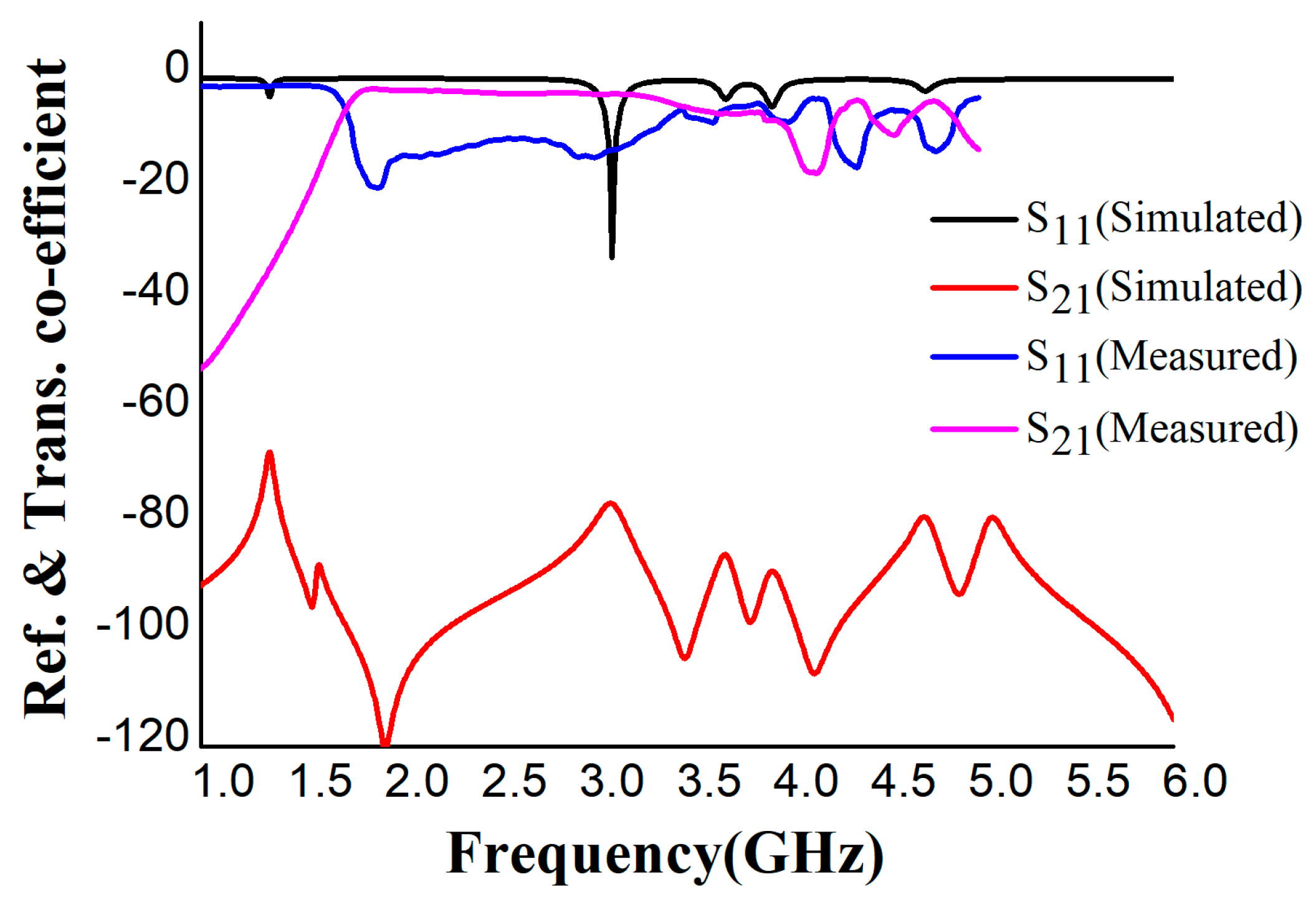
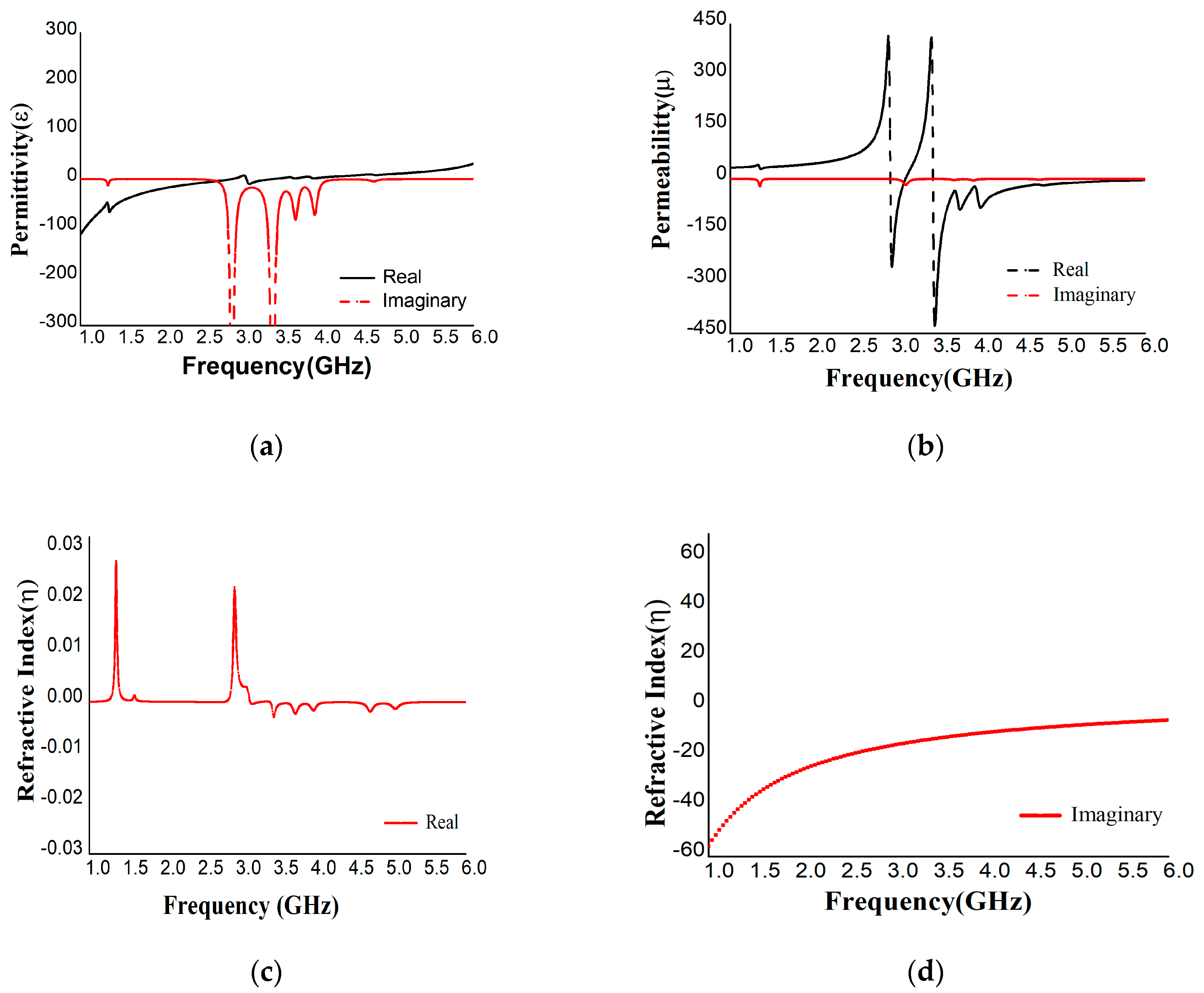
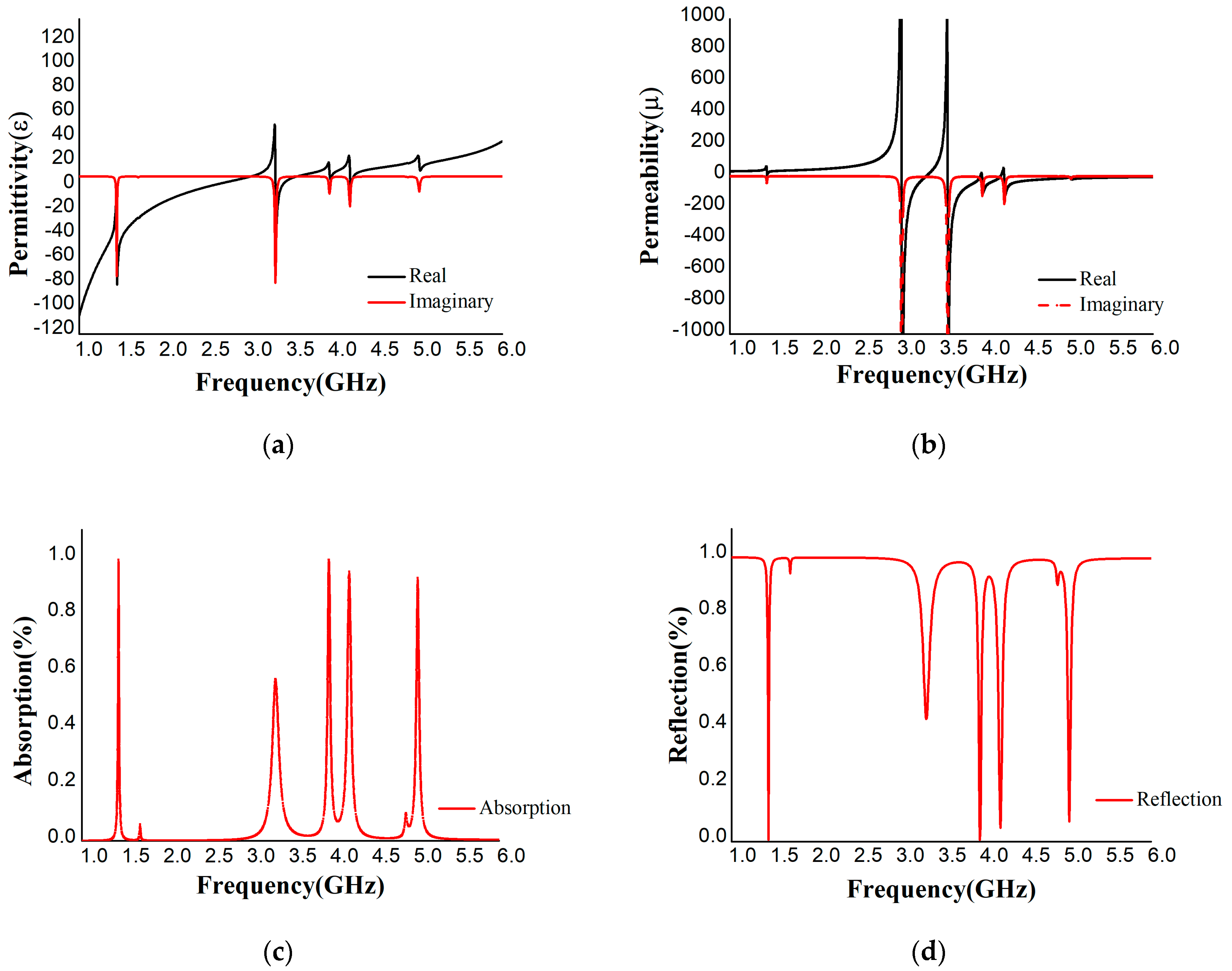
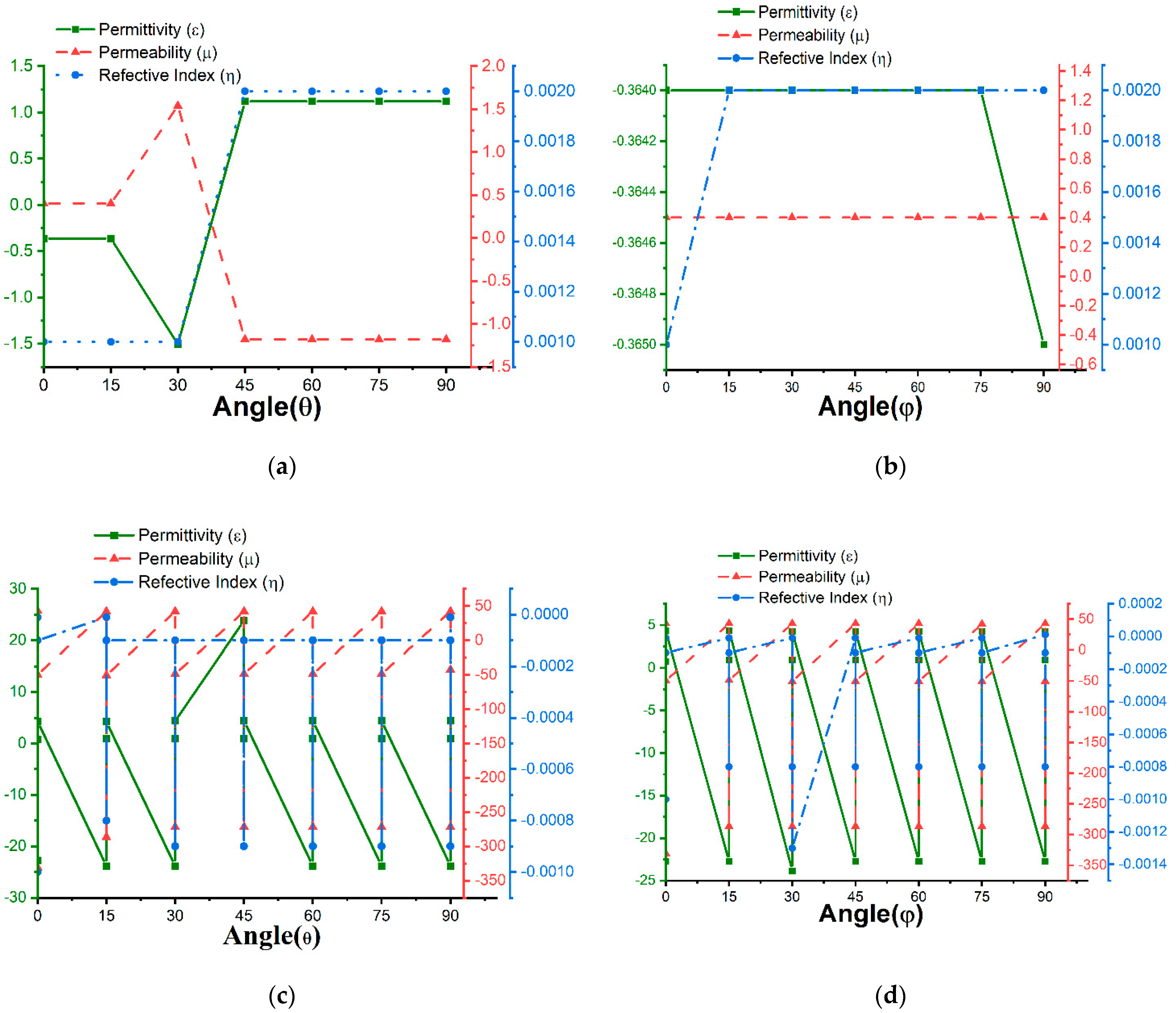



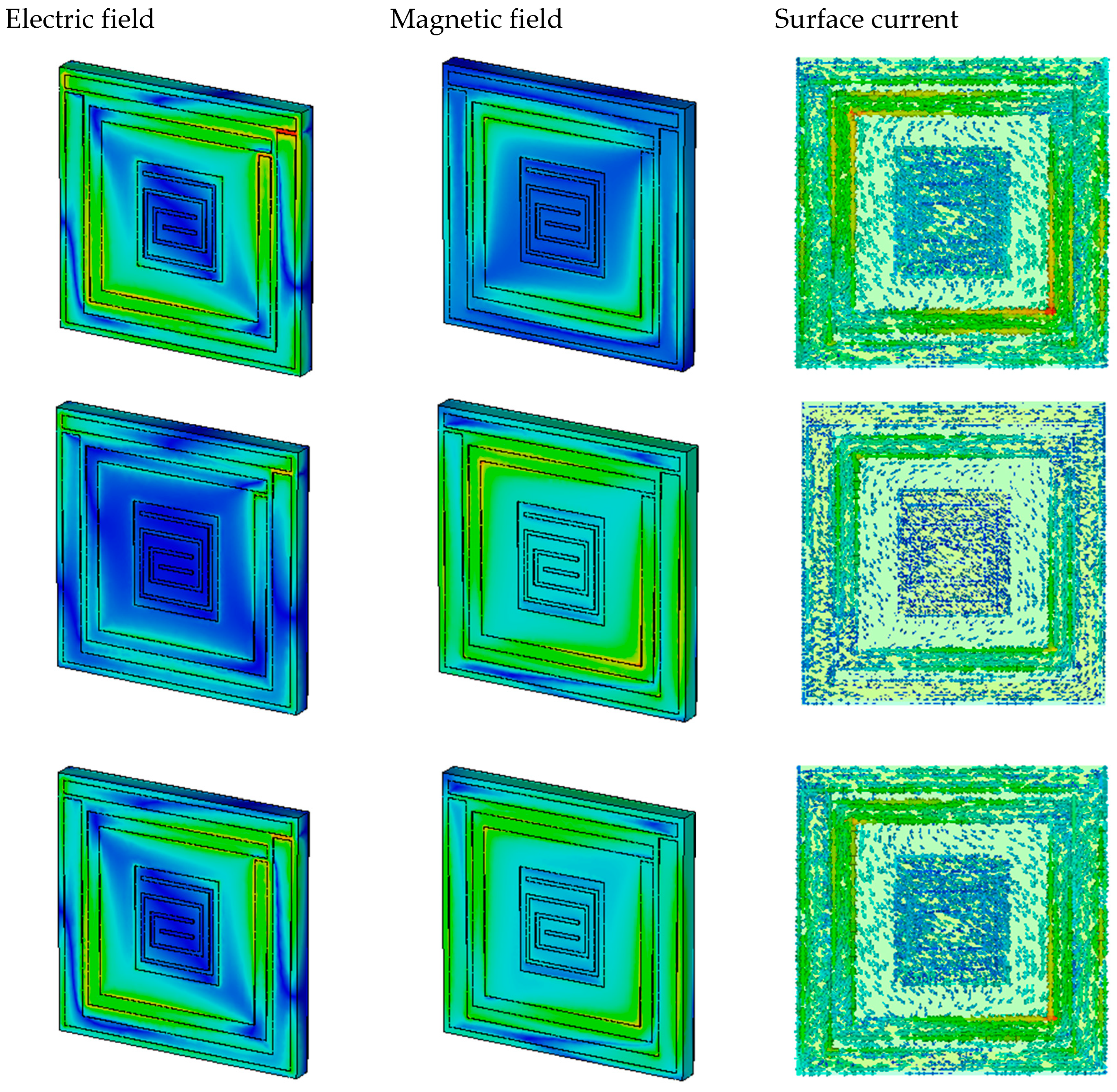
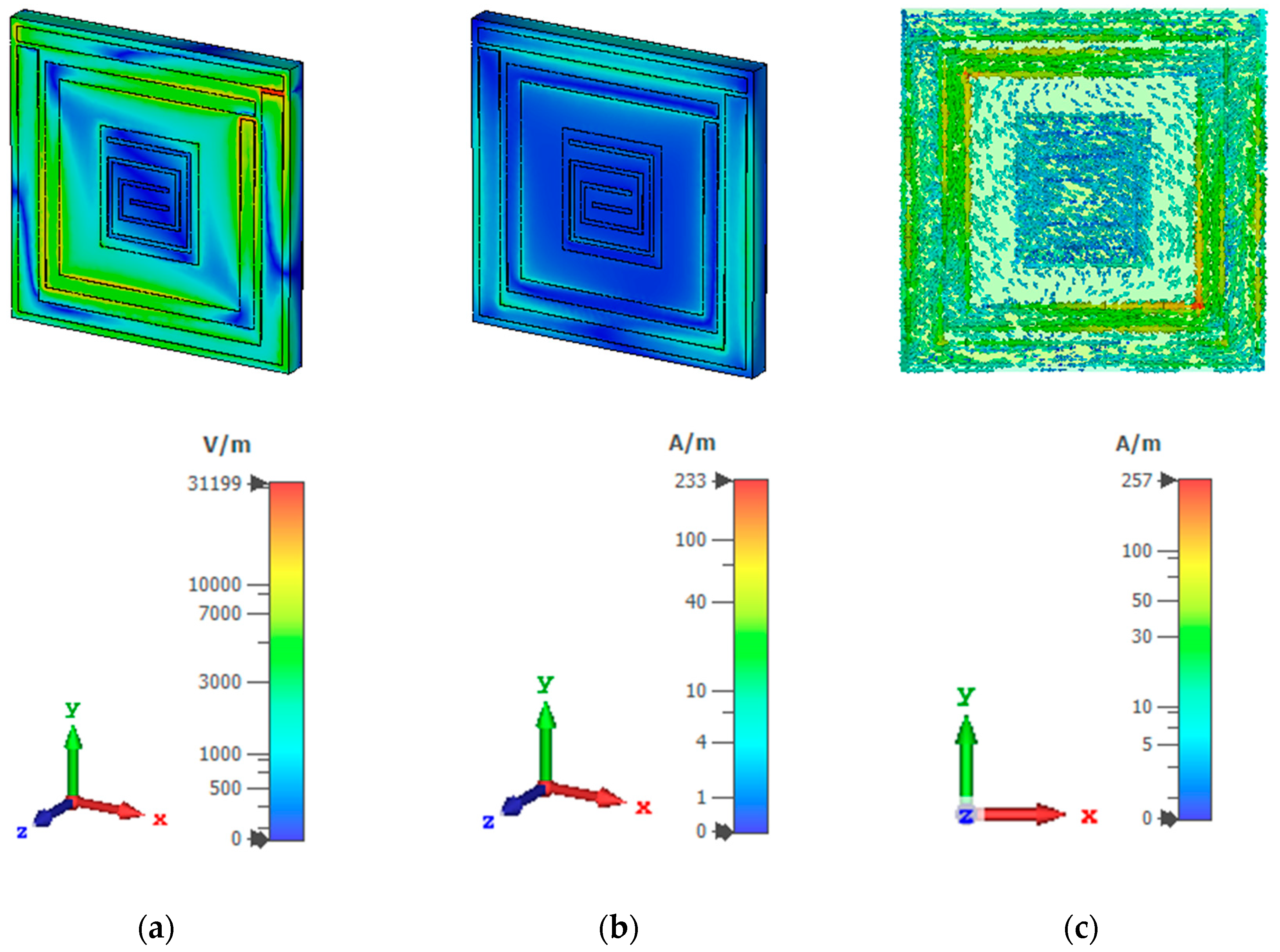
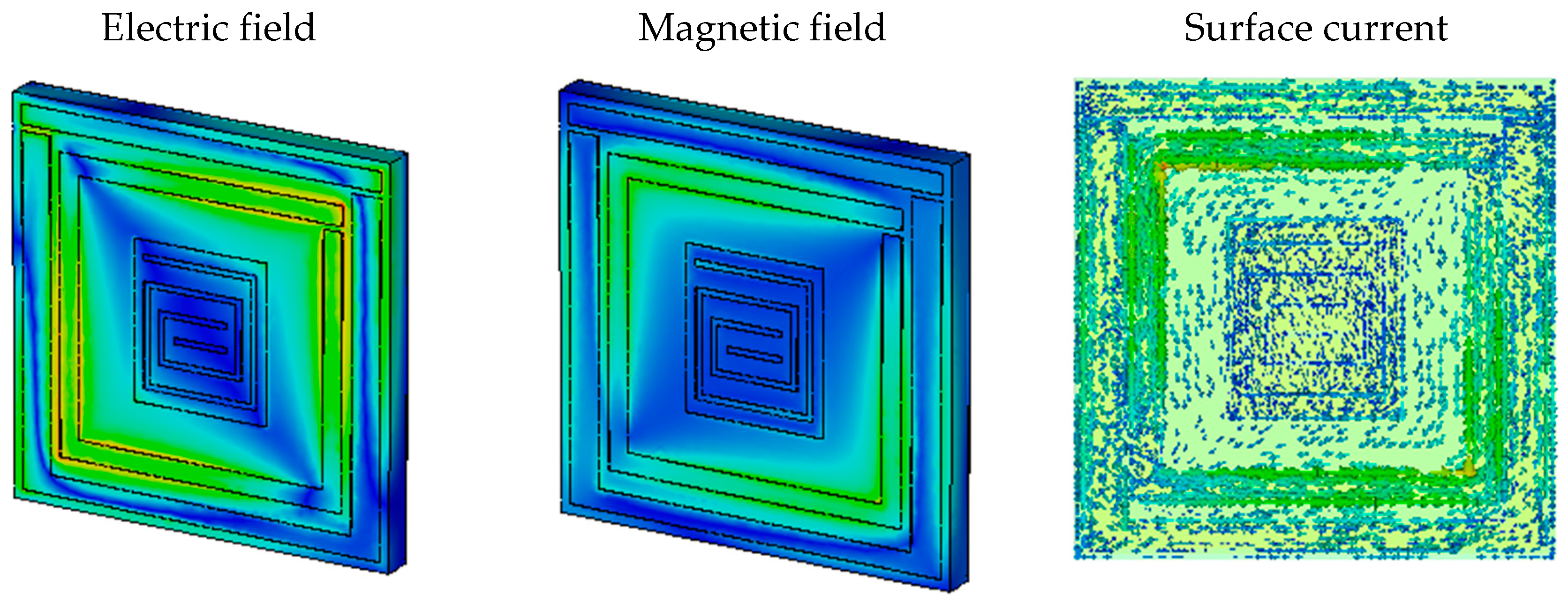

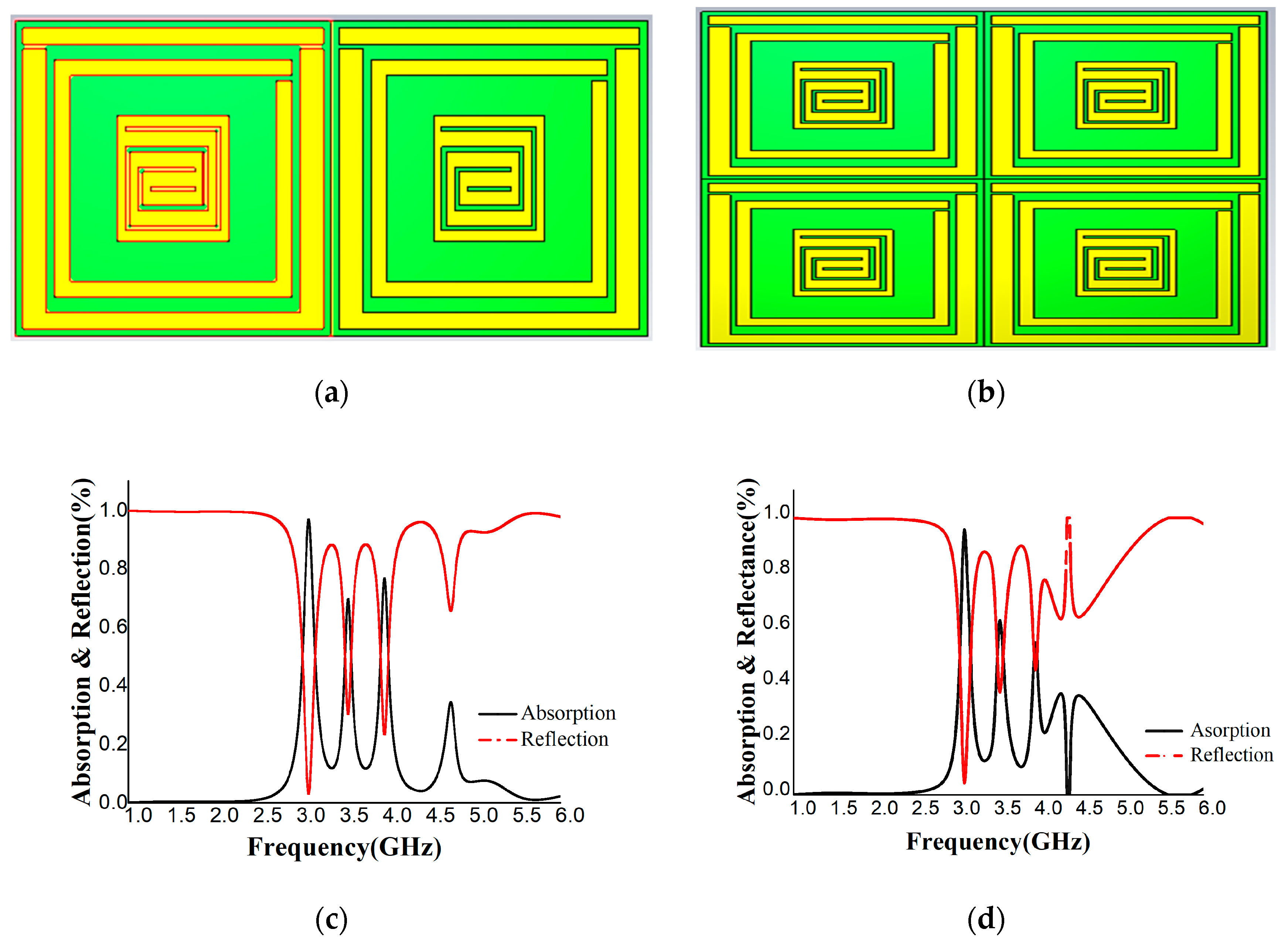
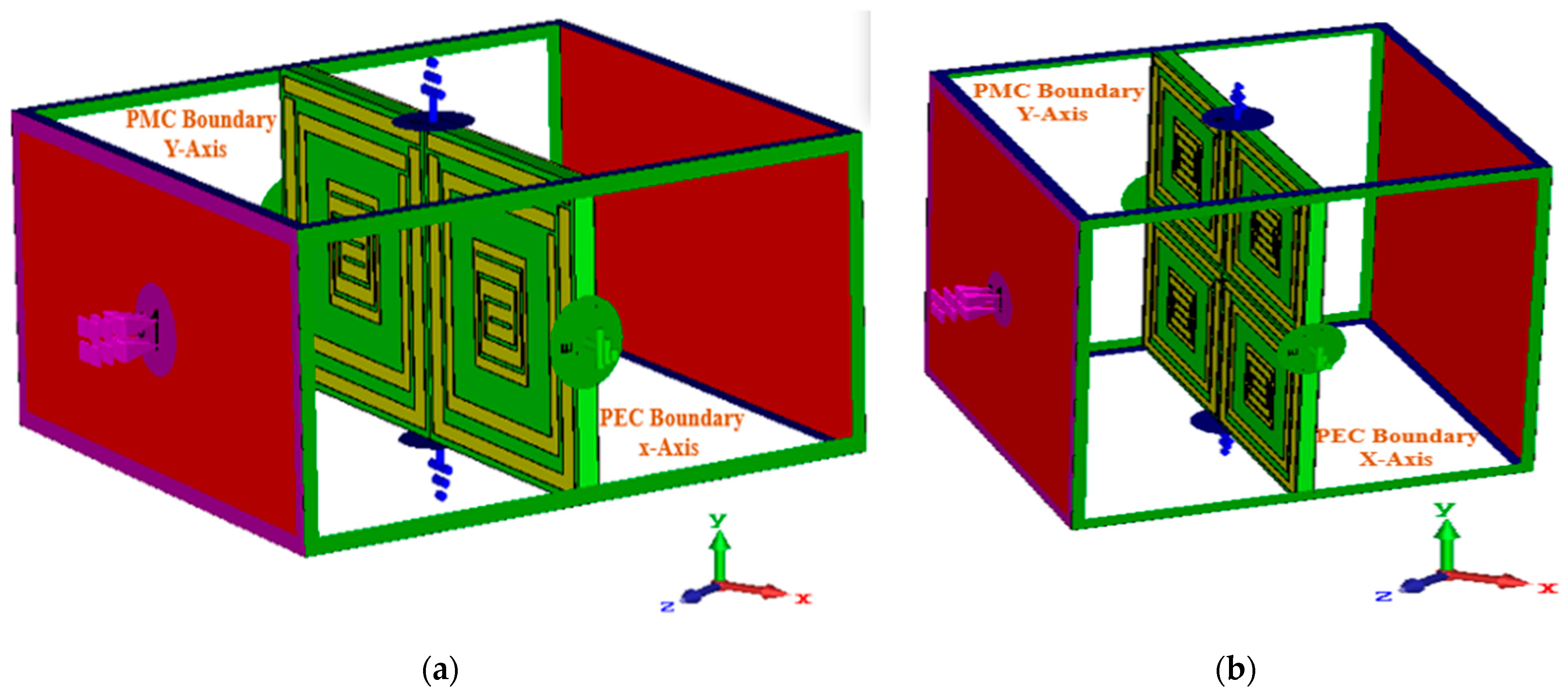
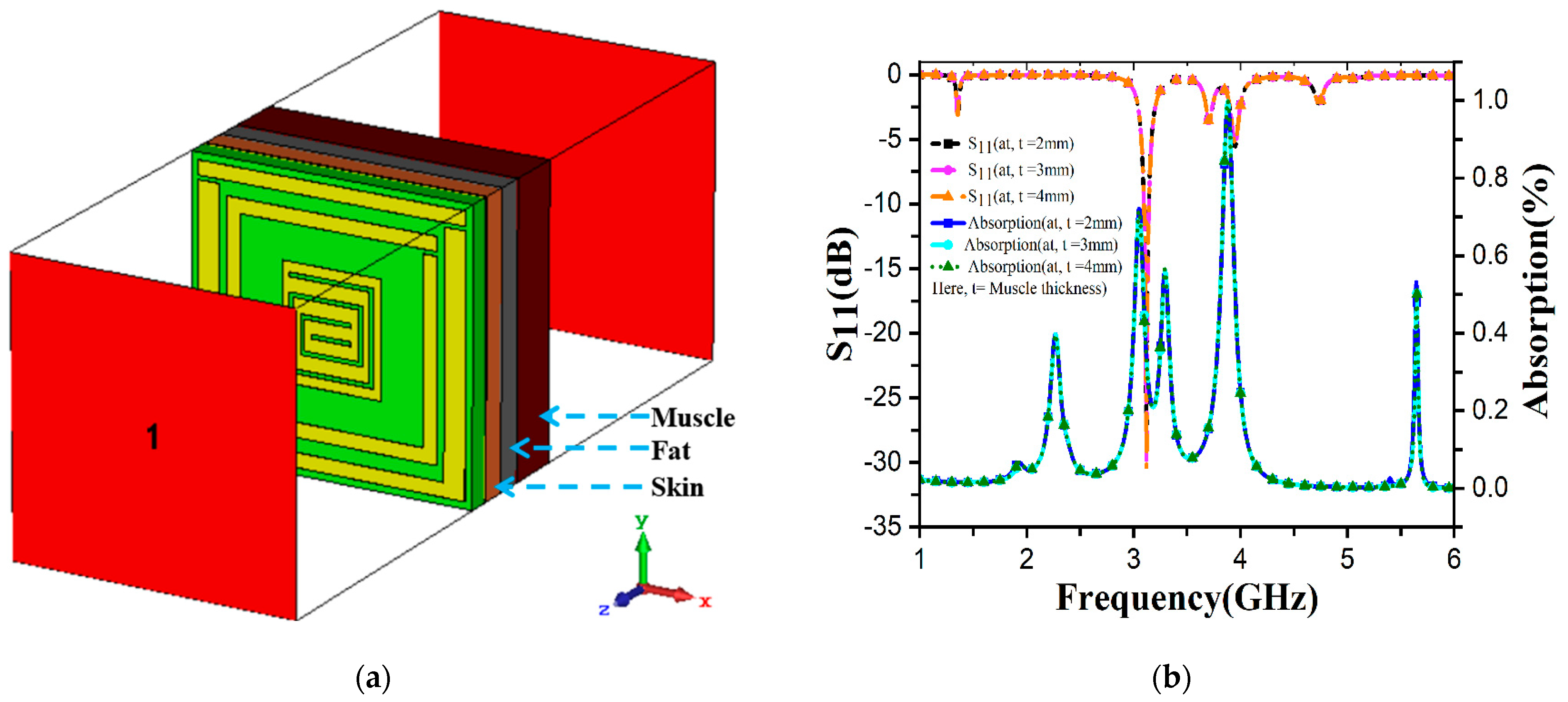
| Ref. # | Size (mm) | Design Structure | Proposed Band | Absorption (%) | Publishing Year |
|---|---|---|---|---|---|
| Hoque et al. [15] | 20 × 20 | Ring C-shaped | Ku | 99.6 | 2018 |
| Rasheduzzaman Sifat [34] | 8 × 8 | Modified C-shaped | S-band | Not mentioned | 2017 |
| Md.Mehedi Hasan [35] | 8 × 10 | Reformed I-shaped | S-, C-, and Ku-band | Not mentioned | 2017 |
| Mohammad Jakir Hossain [36] | 12 × 12 | Double C-shaped | S-, C-, X-band | Not mentioned | 2017 |
| M.F Zafar et al. [44] | 8 × 8 | L-shaped | X-band | 90 | 2021 |
| Kollatou et al. [45] | 8 × 8 | Modified square | X-band | 95.81 | 2013 |
| Borhan et al. [46] | 12 × 12 | O-shaped | X-band | 98.90 | 2016 |
| Prakash Ranjan [47] | 9 × 9 | Square-shaped | X-band | 99.92 | 2019 |
| Mohamood et al. [48] | 16 × 16 | S-shaped | X-band | 90.00 | 2017 |
| Bruno de Araujo [49] | Not mension | V-shaped | Ku | 99.8 | 2020 |
| Zhi Weng [50] | 0.00067 × 0.00144 | Circular-shaped | Optical Range | 99 | 2019 |
| Ke Bi [51] | 9000 × 9000 | Square-shaped | Terahertz | Not mentioned | 2019 |
| Ke Bi [52] | 2 × 2 × 1 | Cube/Rectangular-shaped | Terahertz | Not mentioned | 2021 |
| Jianchun Xu [53] | 12 × 12 | Circular/rectangular-shaped | C-, X-band | Not mentioned | 2019 |
| Yunsheng Guo [54] | 2 × 2 × 2 | Cube-shaped | Ku-band | Tunable Absorption up to 100% | 2017 |
| Proposed paper | 20 × 20 | Rectangular-shaped | S-band | 99.94 | 2022 |
| Thickness(mm) | Permittivity | Conductivity [S/m] | |
|---|---|---|---|
| Skin | 2 | 41.982 | 2.0168 |
| Fat | 2 | 5.2138 | 0.13497 |
| Muscle | 2/3/4 | 2.2216 | 51.936 |
Disclaimer/Publisher’s Note: The statements, opinions and data contained in all publications are solely those of the individual author(s) and contributor(s) and not of MDPI and/or the editor(s). MDPI and/or the editor(s) disclaim responsibility for any injury to people or property resulting from any ideas, methods, instructions or products referred to in the content. |
© 2023 by the authors. Licensee MDPI, Basel, Switzerland. This article is an open access article distributed under the terms and conditions of the Creative Commons Attribution (CC BY) license (https://creativecommons.org/licenses/by/4.0/).
Share and Cite
Sakib, S.; Hoque, A.; Rahim, S.K.B.A.; Singh, M.; Sahar, N.M.; Islam, M.S.; Soliman, M.S.; Islam, M.T. A Central Spiral Split Rectangular-Shaped Metamaterial Absorber Surrounded by Polarization-Insensitive Ring Resonator for S-Band Applications. Materials 2023, 16, 1172. https://doi.org/10.3390/ma16031172
Sakib S, Hoque A, Rahim SKBA, Singh M, Sahar NM, Islam MS, Soliman MS, Islam MT. A Central Spiral Split Rectangular-Shaped Metamaterial Absorber Surrounded by Polarization-Insensitive Ring Resonator for S-Band Applications. Materials. 2023; 16(3):1172. https://doi.org/10.3390/ma16031172
Chicago/Turabian StyleSakib, Shihabun, Ahasanul Hoque, Sharul Kamal Bin Abdul Rahim, Mandeep Singh, Norsuzlin Mohd Sahar, Md. Shabiul Islam, Mohamed S. Soliman, and Mohammad Tariqul Islam. 2023. "A Central Spiral Split Rectangular-Shaped Metamaterial Absorber Surrounded by Polarization-Insensitive Ring Resonator for S-Band Applications" Materials 16, no. 3: 1172. https://doi.org/10.3390/ma16031172
APA StyleSakib, S., Hoque, A., Rahim, S. K. B. A., Singh, M., Sahar, N. M., Islam, M. S., Soliman, M. S., & Islam, M. T. (2023). A Central Spiral Split Rectangular-Shaped Metamaterial Absorber Surrounded by Polarization-Insensitive Ring Resonator for S-Band Applications. Materials, 16(3), 1172. https://doi.org/10.3390/ma16031172







